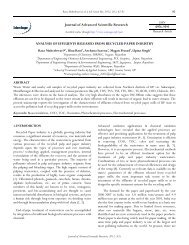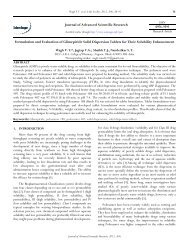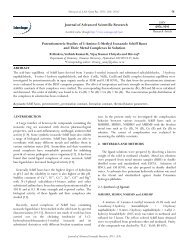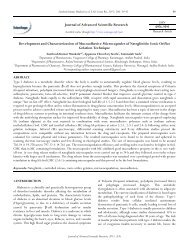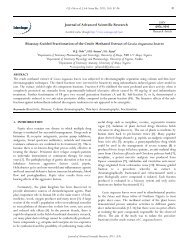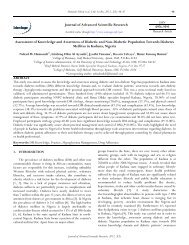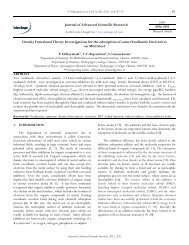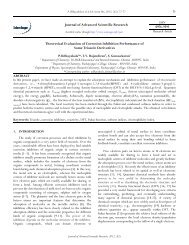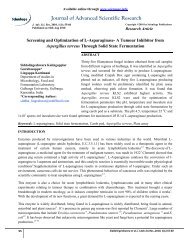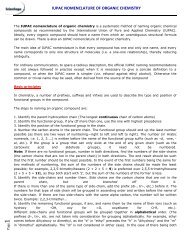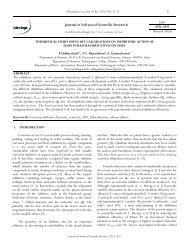Halloysite Nanotubes and Applications: A Review - Sciensage.info
Halloysite Nanotubes and Applications: A Review - Sciensage.info
Halloysite Nanotubes and Applications: A Review - Sciensage.info
You also want an ePaper? Increase the reach of your titles
YUMPU automatically turns print PDFs into web optimized ePapers that Google loves.
• Maintains uniform, sustained release rates <strong>and</strong> no initial<br />
overdosage<br />
• Capable of prohibiting release unless triggered <strong>and</strong> tuneable<br />
release rates<br />
• Protects active agent within its lumen during harsh material<br />
processing<br />
• Capable of loading multiple active agents simultaneously<br />
• Reduces the volume of costly active agents<br />
• Implementable in many forms such as powders, creams, gels,<br />
lotions <strong>and</strong> sprays<br />
• Superior loading rates to other carriers, Fast adsorption rate<br />
<strong>and</strong> high adsorption capacity<br />
• High aspect ratio, high porosity <strong>and</strong> non swelling<br />
• Regeneration ability <strong>and</strong> increased efficacy<br />
2.2. Physical Properties [3]<br />
‣ <strong>Halloysite</strong> specifications (used in research studies)<br />
‣ Typical specific surface area - 65 m2/g<br />
‣ Pore volume ~ 1.25 mL/g<br />
‣ Refractive index - 1.54<br />
‣ Specific gravity - 2.53 g/cm3<br />
‣ Average tube diameter - 50 nm<br />
‣ Inner lumen diameter - 15 nm<br />
2.3. Electro-Chemical Properties [4]<br />
1. The outer surface of the halloysite nanotubes has properties<br />
similar to SiO 2 with negative charge at pH 6 – 7 (zeta<br />
potential) while the inner cylinder core is related to Al 2 O 3<br />
which is slightly positively charged.<br />
Ravindra Kamble et al, J Adv Scient Res, 2012, 3(2): 25-29 26<br />
Fig. 2: Chemical representation of HNT<br />
3. TYPES OF HALLOYSITE NANOTUBE [8,9]<br />
Two types of halloysite nanotubes models are developed<br />
for effective studies in field of nanotechnology.<br />
Single Walled Halloylsite Nanotube Model<br />
Multi Walled Halloylsite Nanotube Model<br />
2. The positive (below pH 8.5) charge of the inner lumen<br />
promotes loading of halloysite nanotubes with negative<br />
macromolecules within void spaces, which are at the same<br />
time repelled from the negatively charged outer surfaces.<br />
2.4. <strong>Halloysite</strong> Cytotoxicity <strong>and</strong> Cytocompability [5-7]<br />
The current research suggests that HNTs are not toxic for<br />
cells <strong>and</strong> those with 50 to 70 nm in external diameter, 15 nm<br />
diameter lumen <strong>and</strong> 1to 0.5 µm in length are chemically<br />
stable.<br />
2.5. Chemistry [8]<br />
<strong>Halloysite</strong> (Al 2 Si 2 O 5 (OH) 4 .2H 2 0) is chemically related to<br />
kaolin. HNTs contain two types of hydroxyl groups, inner <strong>and</strong><br />
outer hydroxyl groups, which are situated between layers <strong>and</strong><br />
on the surface of the nanotubes, respectively. The surface of<br />
HNTs is mainly composed of O Si O groups, <strong>and</strong> the siloxane<br />
surface.<br />
Fig. 3: HNT model<br />
4. LOADING OF HALLOYSITE NANOTUBES [10]<br />
A vial containing the mixture of halloysite <strong>and</strong> saturated<br />
solution of targeted molecules was transferred to a vacuum jar<br />
<strong>and</strong> then repeatedly evacuated using a vacuum pump.<br />
Slight fizzing of the suspension indicates the air being<br />
removed from the halloysite interior. After the fizzing<br />
stopped, the vial was sealed for 30 minutes to reach<br />
equilibrium in molecule distribution.<br />
The halloysite suspension was centrifuged to remove<br />
excess dissolved molecules <strong>and</strong> washed.<br />
The process may be repeated twice to ensure that the<br />
halloysite is filled with the maximum amount of the<br />
targeted molecules.<br />
With this simple loading technique, nanotubule lumen can<br />
be filled with any material.<br />
Journal of Advanced Scientific Research, 2012, 3(2)



